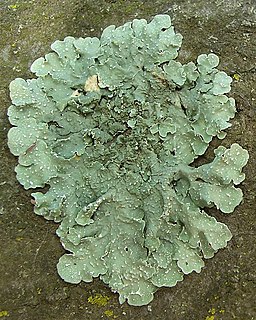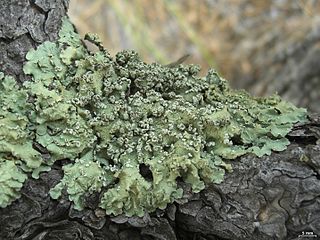
Parmelia is a genus of medium to large foliose lichens. It has a global distribution, extending from the Arctic to the Antarctic continent but concentrated in temperate regions. There are about 40 species in Parmelia. In recent decades, the once large genus Parmelia has been divided into a number of smaller genera according to thallus morphology and phylogenetic relatedness.

Hypogymnia is a genus of foliose lichens in the family Parmeliaceae. They are commonly known as tube lichens, bone lichens, or pillow lichens. Most species lack rhizines that are otherwise common in members of the Parmeliaceae, and have swollen lobes that are usually hollow. The lichens usually grow on the bark and wood of coniferous trees.

Myelochroa is a genus of foliose lichens in the family Parmeliaceae. They are commonly known as axil-bristle lichens. It was created in 1987 to contain species formerly placed in genus Parmelina that had a yellow-orange medulla due to the presence of secalonic acids. Characteristics of the genus include tightly attached thalli with narrow lobes, cilia on the axils, and a rhizinate black lower surface. Chemical characteristics are the production of zeorin and related triterpenoids in the medulla. Myelochroa contains about 30 species, most of which grow on bark. The genus has centres of distribution in Asia and North America.

Flavoparmelia is a genus of foliose lichens in the family Parmeliaceae. Because of their appearance, they are commonly known as greenshield lichens. The widely distributed genus contains 32 species. It was circumscribed by American lichenologist Mason Hale in 1986 to contain 17 former Pseudoparmelia species with broad lobes, usnic acid in the cortex, and isolichenan in the cell walls.

Canoparmelia is a genus of lichen-forming fungi in the family Parmeliaceae. The widespread genus contains about 35 species. Canoparmelia, a segregate of the parmelioid lichen genus Pseudoparmelia, was circumscribed by John Elix and Mason Hale in 1986.

Bulbothrix is a genus of lichen-forming fungi in the family Parmeliaceae. This genus is synonymous with Bulbothricella V.Marcano, S.Mohali & A.Morales. Bulbothrix was circumscribed by lichenologist Mason E. Hale in 1974 with Bulbothrix semilunata as the type species.

Parmelinella is a genus of lichen belonging to the family Parmeliaceae. The genus was circumscribed in 1987 by John Elix and Mason Hale as a segregate of Parmelina, from which it differs in having larger ascospores and containing salazinic acid. Although the genus had been assumed to be well-defined morphologically, a 2021 molecular phylogenetic study suggests that the generic delimitations need to be revised.

Punctelia is a genus of foliose lichens belonging to the large family Parmeliaceae. The genus, which contains about 50 species, was segregated from genus Parmelia in 1982. Characteristics that define Punctelia include the presence of hook-like to thread-like conidia, simple rhizines, and point-like pseudocyphellae. It is this last feature that is alluded to in the vernacular names speckled shield lichens or speckleback lichens.

Relicina is a genus of foliose lichens belonging to the large family Parmeliaceae. It contains 59 species. Relicina was originally conceived as a series of the large genus Parmelia by lichenologists Mason Hale and Syo Kurokawa in 1964. A decade later, they promoted it to the status of genus.
Parmotremopsis is a genus of lichen-forming fungi in the family Parmeliaceae. The genus was circumscribed in 1987 by lichenologists John Elix and Mason Hale.
Punctelia negata is a little-known species of foliose lichen in the family Parmeliaceae. It is found in South America.

Punctelia punctilla is a species of foliose lichen in the family Parmeliaceae. It is found in Africa, South America, and North America, where it grows on bark and on rocks. The main characteristics that distinguish Punctelia punctilla from other species of Punctelia are the presence of isidia on the thallus surface, a pale brown thallus undersurface, and the presence of lecanoric acid in the medulla.

Flavopunctelia flaventior is a species of foliose lichen in the family Parmeliaceae. It was first formally described as a new species by James Stirton in 1877 as Parmelia flaventior. In 1982, Hildur Krog transferred it to the subgenus Flavopunctelia of her newly circumscribed genus Punctelia, created to contain Parmelia species with punctate (point-like) pseudocyphellae. Mason Hale raised this subgenus to generic status a couple of years later, setting Flavopunctelia flaventior as the type species of the new genus. The lichen is commonly known as the speckled greenshield. Flavopunctelia flaventior occurs in Asia, Europe, East Africa, North America, and South America.
Flavopunctelia darrowii is a species of foliose lichen in the family Parmeliaceae. It was first formally described as a new species by John Walter Thomson in 1950 as Parmelia darrowi. It is named after American botanist Robert Arthur Darrow. In 1982, Hildur Krog transferred it to the subgenus Flavopunctelia of her newly circumscribed genus Punctelia, created to contain Parmelia species with punctate (point-like) pseudocyphellae. Mason Hale raised this subgenus to generic status a couple of years later.
Flavopunctelia praesignis is a species of foliose lichen in the family Parmeliaceae. It was first described as Parmelia praesignis by Finnish botanist William Nylander in 1872. In 1982, Hildur Krog transferred it to the subgenus Flavopunctelia of her newly circumscribed genus Punctelia, created to contain Parmelia species with punctate (point-like) pseudocyphellae. Mason Hale raised this subgenus to generic status a couple of years later. The lichen is colloquially known as the fruiting speckled greenshield. It is found in the southern United States, in various states of Mexico, and in South America. It has also been reported from Kenya, but that may be due to misidentification.

Flavopunctelia soredica is a species of foliose lichen in the family Parmeliaceae. It was first described as Parmelia soredica by Finnish botanist William Nylander in 1872. In 1982, Hildur Krog transferred it to the subgenus Flavopunctelia of her newly circumscribed genus Punctelia, created to contain Parmelia species with punctate (point-like) pseudocyphellae. Mason Hale raised this subgenus to generic status a couple of years later. The lichen is colloquially known as the powder-edged speckled greenshield. It is widely distributed, having been recorded from North America, South America, South Africa, India, Russia, China and Japan.

Punctelia perreticulata is a widely distributed species of foliose lichen in the family Parmeliaceae. It occurs in Mediterranean Europe and Russia, North America, South America, Australia, and New Zealand, where it grows on rocks, bark, or wood. Its main distinguishing features are its thallus surface, marked with many shallow depressions, grooves, or pits, and sorediate pseudocyphellae. The lower side of the thallus is ivory to tan towards the centre and the major secondary metabolite in the medulla is lecanoric acid. A lookalike species with which it has been historically confused is Punctelia subrudecta; this lichen can be distinguished from Punctelia perreticulata by the texture of the thallus surface, or, more reliably, by the length of its conidia.

Punctelia stictica is a species of foliose lichen in the family Parmeliaceae. It is widely distributed lichen, recorded in Africa, Europe, North America, South America, and Greenland. It is typically found growing on rocks.

Punctelia borreri is a species of foliose lichen in the family Parmeliaceae. It is a common and widely distributed species, occurring in tropical, subtropical, and temperate regions of Africa, Asia, Europe, North America, Oceania, and South America. The lichen typically grows on bark of deciduous trees, and less commonly on rock. Some European countries have reported increases in the geographic range or regional frequency of the lichen in recent decades, attributed alternatively to a reduction of atmospheric sulphur dioxide levels or an increase in temperatures resulting from climate change.














